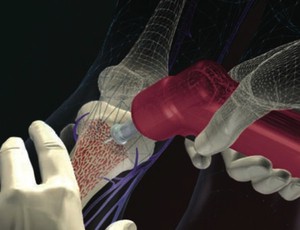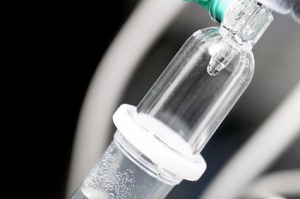Use of intraosseous needles in neonates

IO access should be available on neonatal units and considered for early use in neonates where other access routes have failed” Scrivens et al(2019). Abstract: BACKGROUND: The use of intraosseous (IO) access during resuscitation is widely accepted and promoted in paediatric medicine but features less prominently in neonatal training. Whilst umbilical venous catheterization (UVC) is […]
Compartment syndrome of the leg following IO needle Insertion

Intraosseous (IO) needles are used in patients who are critically ill when it is not possible to obtain venous access” Kibrik et al (2019). Abstract: Intraosseous (IO) needles are used in patients who are critically ill when it is not possible to obtain venous access. While IO allows for immediate access, IO infusions are associated […]
Intraosseous administration of hypertonic saline solution

Intraosseous (IO) access is an alternative method of medication and fluid delivery which is not associated with life-threatening complications and can be inserted faster than CVCs” Lawson et al (2019). Abstract: BACKGROUND: Central venous catheters are often used to administer hypertonic saline (HTS) but might be associated with serious complications. Intraosseous (IO) access is an […]
Intramuscular hemorrhage and fluid extravasation following IO placement

Fluid extravasation is a possible complication of intraosseous needle access that can lead to compartment syndrome” Wasserman et al (2019). Abstract: Intraosseous needle access is a reliable method of vascular access used for rapid fluid resuscitation and delivery of medications in certain emergent settings. Fluid extravasation is a possible complication of intraosseous needle access that […]
Intraosseous flow rates and ease of placement in canine cadavers

To compare intraosseous catheter placement difficulty, success rates, and flow rates at four different locations in canine cadavers” Lange et al (2019). Abstract: Objective: To compare intraosseous catheter placement difficulty, success rates, and flow rates at four different locations in canine cadavers. Design: Prospective study. Setting: Private referral center. Animals: Eleven fresh canine cadavers. Interventions: […]
Malposition of intraosseous needles in pediatric patients

Aim of the study was to describe the rates of malposition of intraosseous needles (ION) in pediatric cadavers via post-mortem computed tomography (PMCT)” Maxien et al (2019). Abstract: AIM OF THE STUDY: Intraosseous vascular access is a commonly conducted procedure especially in pediatric resuscitation. Very high success rates for intraosseous (IO) devices are reported. Aim […]
Extravasation from a misplaced intraosseous catheter

Due to extravasation of the medications, the patient suffered localized tissue necrosis and eventually required skin grafting. This case illustrates the importance of confirming appropriate IO placement” Sampson (2019). Abstract: A 75-year old female presented in cardiac arrest with a right tibial intraosseous (IO) catheter through which prehospital medications were administered. The catheter, which had […]
Comparison of intraosseous versus arterial and venous blood sampling

There is no consensus regarding whether and which laboratory analyses may be performed on IO aspirates, and research on hemodynamically unstable subjects is limited” Strandberg et al (2019). Abstract: BACKGROUND: Intraosseous (IO) access is often indicated for administration of drugs and fluids in emergencies when venous access is challenging. There is no consensus regarding whether […]
Point-of-care analyses of blood samples from intraosseous access

When vascular access is challenging, IO access can be used for emergency POC analyses to help guide clinical decision-making. However, the limitations of IO POC analyses must be carefully considered” Jousi et al (2019). Abstract: BACKGROUND: Intraosseous (IO) access is used for fluid and medication administration in emergency situations when difficulties with vascular access are […]
Intraosseous contrast administration for emergency computed tomography

The aim of the study was to evaluate the feasibility of intraosseous (i.o.) contrast media injection (CMI) for emergency computed tomography (CT) of severe trauma and the associated image quality compared to intravenous (i.v.) CMI” Schindler et al 92019). Abstract: OBJECTIVE: The aim of the study was to evaluate the feasibility of intraosseous (i.o.) contrast […]
Intravenous versus intraosseous access in prehospital cardiac arrest

The aim of this study was to evaluate the effectiveness of IV access versus IO access in terms of return of spontaneous circulation (ROSC) for patients suffering from cardiac arrest” Nguyen et al (2019). Abstract: OBJECTIVE: The prevailing standard of care in prehospital emergency medical services (EMS) is that either intravenous (IV) or intraosseous (IO) […]
Prothrombin complex concentrate administration via intraosseous access

In patients lacking IV access, effective PCC administration becomes problematic. No previous case reports have documented PCC infusion via intraosseous (IO) or alternative routes in this setting” Peyko et al 92019). Abstract: BACKGROUND: Vitamin K antagonist (VKA) reversal in patients with acute major bleeding and coagulopathy is an example of an urgent intervention in the […]
Pediatric prehospital intraosseous access during combat operations

We sought to characterize the use of IO access in pediatric patients who sustained trauma in the combat setting” Schauer et al 92019). Abstract: BACKGROUND: Vascular access in critically ill pediatric patients can be challenging with delays potentially leading to worse outcomes. Intraosseous (IO) access has a low rate of complications and can be utilized […]
The prehospital trauma registry experience with intraosseous access

Within the registry, IO placement was relatively low (<10%) and used in casualties who received several other life-saving interventions at a higher rate than casualties who had IV access” Schauer et al (2019). Abstract: BACKGROUND: Peripheral intravenous (IV) cannulation is often difficult to obtain in a patient with hemorrhagic shock, delaying the appropriate resuscitation of […]
Simulation case involves a child with hypovolemic shock who requires IO needle placement

Interns need to be able to recognize critical illness such as hypovolemic shock, obtain access, and manage complications. This simulation case involves a child with hypovolemic shock who requires intraosseous (IO) needle placement” Rideout and Raszka (2018). Abstract: INTRODUCTION: Volume depletion is a common problem in pediatrics. Interns need to be able to recognize critical […]
Point-of-care laboratory analyses of intraosseous, arterial and central venous samples

The aims of this study were to compare the intraosseous (IO), arterial and central venous POC values during CA and CPR and to see how the CPR values reflect the pre-arrest state” Jousi et al 92019). Abstract: INTRODUCTION: Screening and correcting reversible causes of cardiac arrest (CA) are an essential part of cardiopulmonary resuscitation (CPR). […]
Comparison of two different intraosseous access methods

We wanted to compare the use of a sternal and tibial/humeral intraosseous device in a physician-staffed helicopter emergency medical service” Sørgjerd et al (2019). Abstract: BACKGROUND: Intravenous access in critically ill and injured patients can be difficult or impossible in the field. Intraosseous access is a well-established alternative to achieve access to a noncollapsible vascular […]
End of life palliative sedation via intraosseous vascular access

No complications were noted from this route of administration. We advocate the use of IO access in the palliative care of terminal ill patients when a venous cannulation is not possible” Mansfeld et al (2019). Abstract: Intraosseous (IO) access is normally reserved for emergencies and critical care conditions when venous cannulation is not possible. Nonetheless, […]
Acute tibial osteomyelitis caused by intraosseous access

We report a case of massive acute tibial osteomyelitis in an adult male three months after an IO catheter insertion for emergency drug infusion” Chalopin et al (2018). Abstract: BACKGROUND: Intra-osseous (IO) access is recommended in cases of pre-hospital emergency or resuscitation when intravascular (IV) route is difficult or impossible. Despite recent improvement in IO […]
Serious complications of intraosseous access during infant resuscitation

We report on a 2.5-month-old infant with ischemia of the left leg and compartment following intraosseous needle application during resuscitation” Molacek et al (2018). Abstract: We report on a 2.5-month-old infant with ischemia of the left leg and compartment following intraosseous needle application during resuscitation. Unfortunately, this event led to major limb amputation. The cause, […]
Evaluation of an intraosseous needle causing compartment syndrome

We present a case where point-of-care ultrasound was used to quickly identify a malfunctioning IO needle that resulted in compartment syndrome of the lower extremity” Abramson et al (2018). Abstract: Intraosseous (IO) needles are used in critically ill patients when it is not possible to quickly obtain venous access. While they allow for immediate access, […]
Intraosseous access to administer 23.4% NaCl in the emergency setting

Intraosseous catheterization is an alternative route of venous access that may result in more rapid administration of 23.4% NaCl” Wang et al (2018). Abstract: BACKGROUND/OBJECTIVE: Prompt treatment of acute intracranial hypertension is vital to preserving neurological function and frequently includes administration of 23.4% NaCl. However, 23.4% NaCl administration requires central venous catheterization that can delay […]
Intraosseous access in the treatment of patients after out-of-hospital cardiac arrest

Only a little is known about the frequency of use of supraglottic airway devices (SADs) and intraosseous (IO) access in patients who have had out-of-hospital cardiac arrest (OHCA)” Christ et al (2018). Abstract: INTRODUCTION: Only a little is known about the frequency of use of supraglottic airway devices (SADs) and intraosseous (IO) access in patients […]
Intraosseous administration of hypertonic saline case study

Intraosseous administration of 23.4% saline in 6 adult patients with neurological emergencies was feasible and should be considered in cases where obtaining intravenous access is time consuming” Farrokh et al (2018). Abstract: BACKGROUND: Rapid administration of hypertonic saline 23.4% is crucial in treatment of herniation syndromes. Hypertonic 23.4% saline must be administered via a central […]
Analysis of the intraosseous needle insertion practice improvement registry

Few practice improvement registries exist that describe opportunities to improve intraosseous (IO) use. The goal of this project was to assess the success rate of the procedure by emergency nurses and identify opportunities to improvement” Dymond et al (2018). Abstract: INTRODUCTION: Few practice improvement registries exist that describe opportunities to improve intraosseous (IO) use. The […]
Intraosseous catheter deformation due to positioning patient for thoracostomy

Following removal the intraosseous catheter was noted to be deformed (Fig. 1). A chest radiograph taken prior to removal showed the correct insertion point in the proximal humerus with no evidence of local bony injury, but with a bend in the catheter located at the insertion site” Reid et al (2018). Extract: The intraosseous catheter […]
Emergency department nurses role in establishing intraosseous access

This study aimed to evaluate ED nurses’ success rate in establishing pediatric IO access using semiautomatic devices” Feldman et al (2018). Abstract: BACKGROUND: No study has examined the performance of emergency department (ED) nurses in establishing intraosseous access (IO) access. This study aimed to evaluate ED nurses’ success rate in establishing pediatric IO access using […]
Intraarticular extravasation following intraosseous needle intravenous access

Off label use of intraosseous needles (IONs) for contrast media (CM) injection during computed tomographic angiography (CTA) has been reported in small case series and isolated case reports” Winkler et al (2018). Abstract: Off label use of intraosseous needles (IONs) for contrast media (CM) injection during computed tomographic angiography (CTA) has been reported in small […]
What is the usability of intraosseous blood samples in emergency care patients

The aim of this study was to systematically review the existing literature on the usability of IO blood samples for analysing the parameters relevant to emergency care. We performed a data search from the Medline and Embase databases, the Cochrane Library and the Clinical trials registry” Jousi et al (2018). Abstract: Intraosseous (IO) access is […]
Intraosseous access device comparison of efficacy

As an alternative, medications and fluids can be administered via the intraosseous (IO) route, which is a well-tolerated and established alternative, especially in the emergency setting” Szarpak et al (2018). Abstract: BACKGROUND: Obtaining intravascular access can be challenging or even impossible in several clinical situations. As an alternative, medications and fluids can be administered via […]

